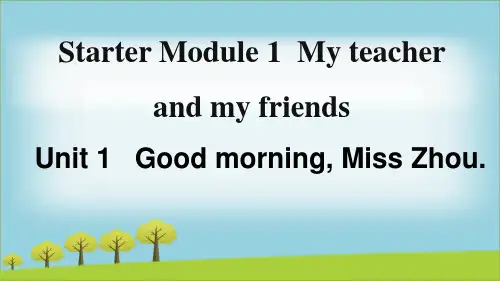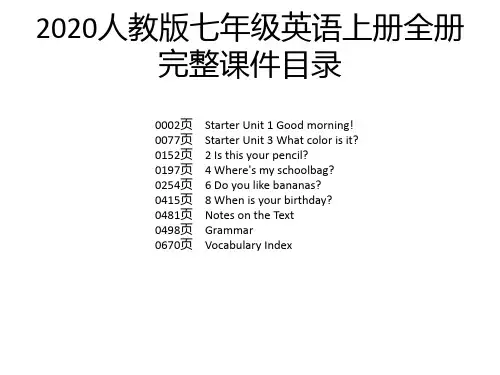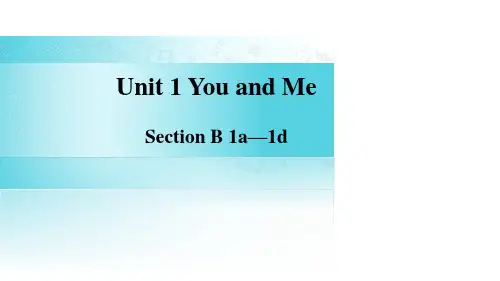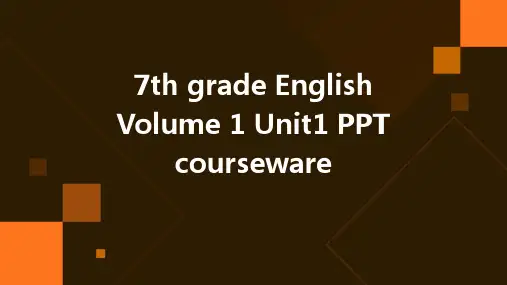七年级上册英语课件
- 格式:ppt
- 大小:913.50 KB
- 文档页数:18
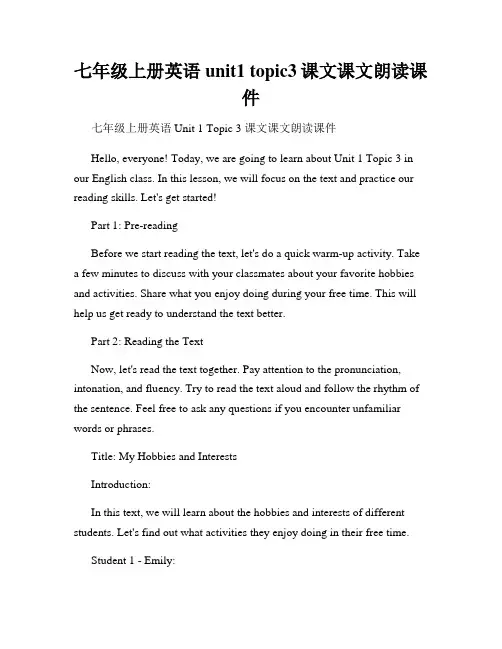
七年级上册英语unit1 topic3课文课文朗读课件七年级上册英语 Unit 1 Topic 3 课文课文朗读课件Hello, everyone! Today, we are going to learn about Unit 1 Topic 3 in our English class. In this lesson, we will focus on the text and practice our reading skills. Let's get started!Part 1: Pre-readingBefore we start reading the text, let's do a quick warm-up activity. Take a few minutes to discuss with your classmates about your favorite hobbies and activities. Share what you enjoy doing during your free time. This will help us get ready to understand the text better.Part 2: Reading the TextNow, let's read the text together. Pay attention to the pronunciation, intonation, and fluency. Try to read the text aloud and follow the rhythm of the sentence. Feel free to ask any questions if you encounter unfamiliar words or phrases.Title: My Hobbies and InterestsIntroduction:In this text, we will learn about the hobbies and interests of different students. Let's find out what activities they enjoy doing in their free time.Student 1 - Emily:Emily loves reading books in her free time. She enjoys both fiction and non-fiction books. Reading helps her relax and expands her knowledge.Student 2 - David:David is passionate about playing the guitar. He takes guitar lessons every week and practices for at least an hour every day. He dreams of becoming a professional musician in the future.Student 3 - Lisa:Lisa is a talented artist. She loves painting and spends hours creating beautiful artworks. Her favorite medium is watercolor, and she often participates in art competitions.Student 4 - Michael:Michael is a sports enthusiast. He enjoys playing basketball with his friends. Michael believes that sports not only keep him physically fit but also teach him teamwork and discipline.Conclusion:In this text, we have learned about the hobbies and interests of four different students. They each have their own unique way of spending their free time. It's important to have hobbies and interests that bring us joy, relax us, and help us grow as individuals.Part 3: Post-reading DiscussionNow that we have read the text, let's discuss it further. In pairs or small groups, answer the following questions:1. What hobbies or activities do you have in common with any of the students mentioned in the text?2. Which student's hobby interests you the most? Why?3. Do you think it's important to have hobbies and interests? Why or why not?Take turns expressing your thoughts and listen to your classmates' opinions. This will help you widen your perspective and understand different viewpoints.Conclusion:In this lesson, we have explored the different hobbies and interests of students. It's important to have activities that bring us joy and help us relax. Whether it's reading, playing music, creating art, or engaging in sports, hobbies play a crucial role in our personal development. Remember to cherish your hobbies and make time for them regularly.That concludes our lesson for today. Great job, everyone! Keep practicing your reading skills and exploring new hobbies. See you next time!。
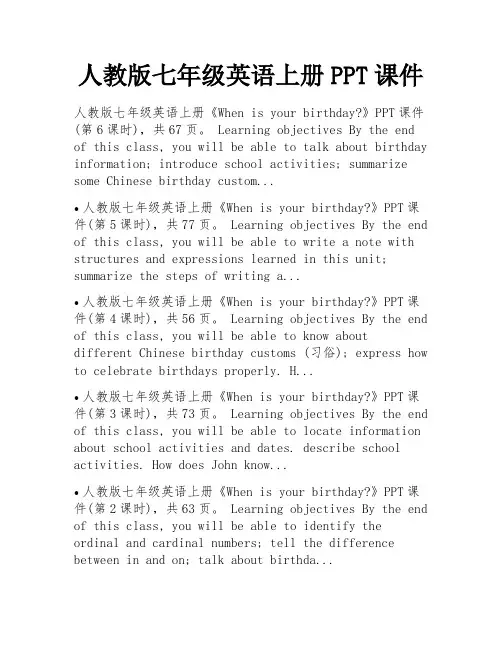
人教版七年级英语上册PPT课件人教版七年级英语上册《When is your birthday?》PPT课件(第6课时),共67页。
Learning objectives By the end of this class, you will be able to talk about birthday information; introduce school activities; summarize some Chinese birthday custom...•人教版七年级英语上册《When is your birthday?》PPT课件(第5课时),共77页。
Learning objectives By the end of this class, you will be able to write a note with structures and expressions learned in this unit; summarize the steps of writing a...•人教版七年级英语上册《When is your birthday?》PPT课件(第4课时),共56页。
Learning objectives By the end of this class, you will be able to know aboutdifferent Chinese birthday customs (习俗); express how to celebrate birthdays properly. H...•人教版七年级英语上册《When is your birthday?》PPT课件(第3课时),共73页。
Learning objectives By the end of this class, you will be able to locate information about school activities and dates. describe school activities. How does John know...•人教版七年级英语上册《When is your birthday?》PPT课件(第2课时),共63页。

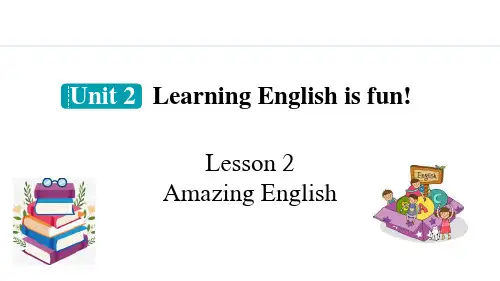
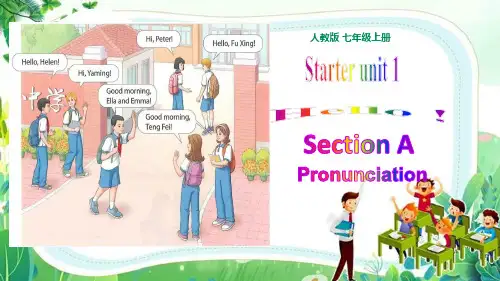
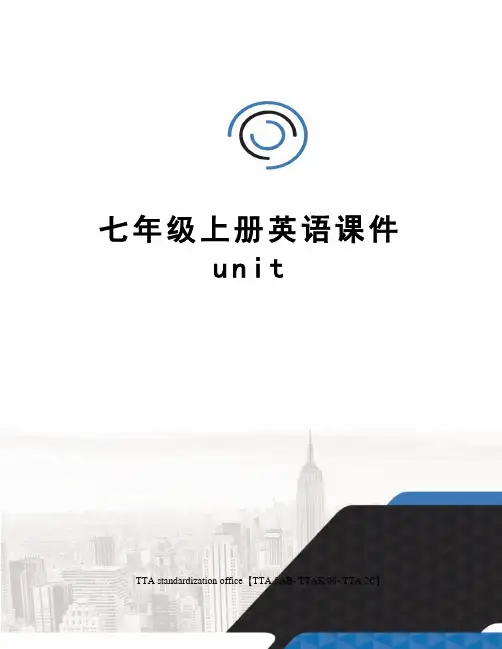
七年级上册英语课件u n i tTTA standardization office【TTA 5AB- TTAK 08- TTA 2C】七年级上 Unit 1 My name's Gina.❖语法详解:形容词性物主代词:概念:形容词性物主代词是用来表示所有关系的代词,有人称和数的变化。
用法:①形容词性物主代词不能单独使用,其后必须接名词,即在名词前作定语。
②形容词性物主代词不能与冠词和指示代词连用。
③形容词性物主代词与形容词一起修饰名词时,其顺序应为:形容词性物主代词+形容词+名词。
如:my red pen 我的红色钢笔BE动词一般疑问句Ⅰ:概念:一般疑问句是指可以用Yes或No回答的疑问句。
本单元主要学习be动词的一般疑问句。
结构:Be动词+主语+其他?回答:Yes,主语+be.(肯定回答)/No,主语+be not.(否定回答) 如:—Is he Jim他是吉姆吗—Yes,he is./No,he isn't.是的,他是。
/不,他不是。
be动词可缩写与不可缩写的情况:be动词可缩写的情况①一般am,is,are与前面的名词或代词缩写时,省去前面的元音字母并在省去的地方加“'”。
如:I am→I'm; what is→what's; you are→you're②not与be动词的缩写形式。
如:are not→aren't; is not→isn'tbe动词不可缩写的情况①this is,am not,those/these are都没有缩写形式。
②在一般疑问句的简略回答中,肯定回答时,代词不能与am,is,are缩写。
如:Are you Tom你是汤姆吗正:Yes,I am. 误:Yes,I'm.❖语法专练一、用所给词的适当形式填空。
1.Hello! ___ (I) am 's ______ (you) name?2.Are _____ Jack(you)3.—How are ______—I'm fine,thank _____.(your)4.—What's _____ name?—_____ name is Tom.(he)5.—Is _____ Alice?—No,_____ isn' name's Mary.(she)二、按要求完成句子。
